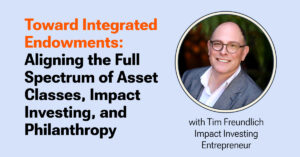Impact and outcomes measurement have been popular buzzwords in the philanthropic community over the last few years. But what does measuring your organization’s impact, outcomes mean? Why is it important to measure the value of your investments? What data do you need for accurate and meaningful results?
In this article, we will explore the clear benefits of using a measurement strategy for your organization and stakeholders. We will discuss why it is important to track the right data and create a strategy. Finally, we will provide some tips on how to get started.
Measurement shows how you’re driving change
The National Council of Nonprofits is among the many organizations that believe philanthropic organizations are responsible and accountable to the communities they serve. It’s important to demonstrate to your stakeholders how your work supports your organization’s mission.
By sharing how you track and report the results of your programs, you improve transparency. This helps you clearly show what you have done to reach your goals. But first, you need to decide how the data can be used to create reports that prove impact.
“The trend is towards understanding how to actually measure the impact your foundation is having on the world,” says Kristian Mørk Puggaard, Managing Partner of DAMVAD Analytics, a SmartSimple partner with offices in Denmark and Sweden. “You may feel that you are driving change, but may not be making as big a difference as you think.”
With the right strategy, you can understand your impact better. Comprehensive measurement practices give you the ability to influence the behavior of your grantees and help them do more good with the funding you provide.
 Photo by Fleur Treurniet
Photo by Fleur Treurniet
A difference exists between measuring impact and measuring outcomes
“The difference between measuring impact and measuring outcomes has much to do with the various stages of the granting process,” continues Kristian. “Starting with the initial input, the resources allotted at the start.
Next comes the activities, which look at how you plan to achieve your goal. The output phase takes a look at how well your programs performed, followed by the outcome of this work and what was ultimately achieved.” But even if you achieve your projected outcome, that’s no guarantee of a successful outcome.
“Impact measures what was actually changed based on the effect of your activities and outcomes. This speaks to the overall change made thanks to the other phases of the work you’ve done.”
One global family foundation that has been providing grants for more than 30 years, created a tool they’ve shared with the philanthropic community. The Data Playbook, available on Creative Commons, a website for the sharing of ideas and resources by organizations around the world. This playbook outlines a 5-stage logic model (also known as logical framework) with a toolkit any organization can use to get started on the road to impact and outcomes measurement. Let’s take a closer look at their strategy.
 Photo by Olu Eletu
Photo by Olu Eletu
The 5-stage logic model
The 5-stage logic model serves as a structured framework designed to define your organization’s objectives and monitor your advancement through five distinct phases:
Impact: What specific, measurable changes do you aim to accomplish over the long term?
Outcomes: What measurable changes do you expect to see in the short to medium term? What indicators will suggest that you are progressing towards your long-term objectives?
Outputs: What tangibles can you measure immediately following the program?
Activities: What are the actions that you need to perform to successfully run the program?
Inputs: What resources (money, staff, technology) do you need to invest in the program for it to be successful?
For example, if you want to raise the literacy rates of children in a community by 35% in 5 years:
Decide what impact you want to make
Identify what outcomes will prove success
Determine the outputs that can be measured quickly
List the activities needed to ensure success
Compile the inputs needed to get started
Next, you would need to decide how many children to involve, and what activities can be undertaken to make the most of your resources. This leads to the actual education of the children and using the tools obtained to engage the kids in learning to read.
Once this stage is done, you will see how successful you were. You can tell by the number of students who can read now but could not before. Does this number correlate to the percentage you were hoping to achieve at the start? Did you get close to 35% or even exceed your goal?
After you’ve quantified this number, see how those children put their reading into practice. Are they teaching others to read? Did any of them attend college or university to further their education?
Lastly, we get to the impact management. This is where you can assess what the long-term achievement was. In this case, out of the 100 kids in your program, maybe 75 earned post-secondary degrees and now have full-time jobs. In addition, they are teaching their own children to read, leading to an ongoing change in how this community educates future generations.
This is just one example of a long-term, measurable impact that demonstrates to your stakeholders precisely how well you met your goals and what this means for the future. While this is good, we still need to consider how to gather the right data. This data will help prove accuracy and show the value of your impact.
 Photo by American Public Power Association
Photo by American Public Power Association
A question of data
In the profit-driven sector, a company’s success is primarily gauged by its financial performance. However, depending on the organization’s objectives, various other factors may contribute to the overall assessment of success, including the effectiveness of sustainability efforts, fair hiring practices, customer satisfaction levels, and enhancements in product quality. Nonprofit organizations face the challenge of identifying necessary data to evaluate their impact and results.
Taking a community reading initiative as an example, it’s evident how simple it can be to amass substantial data. For instance, one would need to collect information such as:
The names of the children
The ages of the children
The number of children living in the community
The overall population of the community
The reading test scores
The number of books each child read
The total number of books read by all the students
“A good number of foundations have no strategy and really aren’t thinking about why they collect data or how to define and use the data they do collect.”
This is merely the beginning. You’d need to keep gathering data on students who have pursued higher education, as well as the types of employment opportunities they accessed, especially if any relocated from the area. The resulting list can become extensive and potentially daunting. This is a common hurdle faced by nonprofits of all sizes and varieties, including those that already recognize the critical significance of data collection.
“A good number of foundations have no strategy and really aren’t thinking about why they collect data or how to define and use the data they do collect. There may be a discrepancy between what the administrators of your foundation versus your stakeholders hope to get out of the information. It’s also very time-consuming to gather information without any goals as to how you will use it,” adds Kristian
How does a foundation then begin to form a workable strategy that resonates with their community?
“The best idea is to work closely with your stakeholders to define what your goals are, then start collecting the appropriate data that will meet your strategic goals and help you measure impacts and outcomes,” says Kristian.
You don’t need to be an expert in data measurement to get the process going
Every new initiative needs to start somewhere. Even if data collection seems overwhelming, it can help to take a few small steps to get started.
“Even for small foundations, getting started doesn’t need to be complicated or take too long to do. The point is to simply get started. Begin with what it is you’re doing, why, and what indicators you need to make an impact strategy.
It shouldn’t take any more than a month to get the data together. You don’t need anything too detailed to start. Decide what indicators you need, then start collecting that data from the organizations you fund,” concludes Kristian.
You may even be further along the road to impact and outcomes measurement than you think!
“The point is to simply get started. Begin with what it is you’re doing, why, and what indicators you need to make an impact strategy.”
“If you already have your activities and the relevant output, making the connection between researching your data and collaborating with your peers shouldn’t be too complicated to get yourself started. Get foundation leaders involved and moving towards comprehensive measurement. And ensuring you have an effective data collection process is vital.
This can be achieved through a good system that takes your information, tracks it, and keeps it stored in an organized fashion. That will make it much simpler to extract the necessary details and create thorough reports for your stakeholders that clearly indicate what you have achieved,” concludes Kristian.
 Photo by Patricia Serna
Photo by Patricia SernaAchieving significant results and assessing impact is not an unattainable goal; any organization can identify the necessary data to begin this process. What you need is the motivation to start and the eagerness to discover the extent of your contributions.
Enhancing your measurement efforts can be simplified with our grant management systems. Utilize advanced reporting features alongside our full suite of tracking, budgeting, and collaboration tools to evaluate your social impact effectively.
Contact us today for a demo and explore the capabilities we offer.

